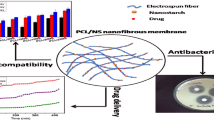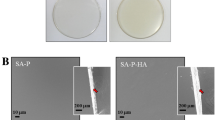Abstract
Doxycycline and monosodium glutamate (MSG) loaded chitosan (CHI)/polylactic acid (PLA)/polycaprolactone (PCL) blend film was studied as a model device to deliver drug to targeted human organ which in this case was the skin with opened wound. The CHI/PLA/PCL blend film containing 60 % CHI, 28 % PLA, and 12 % PCL exhibited the good properties for making the dressing device. It was observed that doxycycline/MSG loaded CHI/PLA/PCL blend film could rapidly deliver both doxycycline and MSG at the high release percentage approaching 100 % loaded. MSG accelerated blood clotting and fibrin formation; thus, it exhibited the good hemostatic activity. The antibacterial activity of doxycycline loaded CHI/PLA/PCL blend film against Staphylococcus aureus and Escherichia coli as model bacteria was investigated. Doxycycline release played the crucial role in bacterial inhibition as observed from the lowest bacterial cell dry weight observed when compared with the control bacterial culture or the bacterial cultures with the presence of other films studied.









Similar content being viewed by others
References
Kathryn EU, Scott MC, Robert SL, Kevin MS. Polymeric systems for controlled drug release. Chem Rev. 1999;9:3181–98.
Zhou S, Song B, Li X. In vitro degradation and release profiles for Poly-dl-lactide film containing paracetamol. J Mater Sci Mater Med. 2007;18:1623–6.
Sahoo S, Sasmal A, Nanda R, Phani AR, Nayak PL. Synthesis of chitosan–polycaprolactone blend for control delivery of ofloxacin drug. Carbohydr Polym. 2009;79:106–13. doi:10.1016/j.carbpol.2009.07.042.
Chen CC, Chueh JY, Tseng H, Huang HM, Lee SY. Preparation and characterization of biodegradable PLA polymeric blends. Biomaterials. 2003;24:1167–73.
Gentry PA. Comparative aspects of blood coagulation. Vet J. 2004;168:238–51.
Urata J, Shojo H, Kaneko Y. Inhibition mechanisms of hematophagous invertebrate compounds acting on the host blood coagulation and platelet aggregation pathway. Biochime. 2003;85:493–500.
Mershon MM. Compositions and methods for reducing blood and fluid loss from open wounds. United States Patent no. 7,303,759 Dec 2007.
Ruiz FA, Lea CR, Oldfield E, Docampo R. Human platelet dense granules contain polyphosphate and are similar to acidocalcisomes of bacteria and unicellular eukaryotes. J Biol Chem. 2004;279:44250–7.
Smith SA, Mutch NJ, Baskar D, Rohloff P, Docampo R, Morrissey JH. Polyphosphate modulates blood coagulation and fibrinolysis. Biochemistry. 2006;103:903–8.
Wynd FL. A possible function of vitamin K in plants. Am Nat. 1944;78:59–67.
Ahuja A, Martin DP, McCarthy SJ. Hemostatic compositions, assemblies, systems, and methods employing particulate hemostatic agents formed from chitosan and including a polymer mesh material of poly-4-hydroxy butyrate. United States Patent no. US2007/0166387 A1 July 2007.
Osoniyi O, Onajobi F. Coagulant and anticoagulant activities in Jatropha curcas latex. J Ethnopharmacol. 2003;89:101–5.
Korsmeyer RC, Peppas NA. Effect of the morphology of hydrophilic polymeric matrices on the diffusion and release of water soluble drugs. J Membr ci. 1981;9:211–27.
Tanveer AK, Peh KK, Ch’ng HS. Mechanical, bioadhesive strength and biological evaluation of Chitosan film for wound dressing. J Pharm Pharm Sci. 2000;3(3):303–11.
Queen D, Gaylor JDS, Ebans JH, Courtney JM. The preclinical evaluation of the water vapour transmission rate through burn wound dressing. Biomaterials. 1987;8:367–71.
Boateng JS, Matthews KH, Stevens HNE, Eccleston GM. Wound healing dressings and drug delivery systems: a review. J Pharm Sci. 2008;97(8):2892–923.
Wang QZ, Chen XG, Li ZX, Wang S, Liu CS, Meng XH, Liu CG, Lvm YH, Yu LJ. Preparation and blood coagulation evaluation of chitosan microspheres. J Mater Sci Mater Med. 2008;19:1371–7.
Edwards JV, Howley P, Prevost N, Condon B, Arnold J, Diegelmann R. Positively and negatively charged ionic modifications to cellulose assessed as cotton-based protease-lowering and hemostatic wound agents. Cellulose. 2009;16:911–21.
Schmidt AE, Stewart JE, Mathur A, Krishnaswamy S, Bajaj SP. Na+ site in blood coagulation factor IXa: effect on catalysis and factor VIIIa binding. J Mol Biol. 2005;350:78–91.
Bowen R. Vitamin K. 1999. http://abl.cumbs.colostate.edu/hbook/pathphysic/misc_topics/vitamink.html. Accessed 12 Dec 2006.
Higdon J. Vitamin K. 2004. http://lpi.oregoustate.edu/infocenter/vitamins/vitamink/.. Accessed 12 Dec 2006.
Tollefsen D. Blood coagulation. 2006. http://tollefsen.wustl.edu/projects/Coagulation/Coagulation.html. Accessed 9 Nov 2006.
Vallapa N, Wiarachai O, Thongchul N, Pan JS, Tangpasuthadol V, Kiatkamjornwong S, Hoven VP. Enhancing antibacterial activity of chitosan surface by heterogeneous quaternization. Carbohy Polym. 2011;83:868–75.
Bi E, Lutkenhaus J. Cell division inhibitors SulA and MinCD prevent formation of the FtsZ ring. J Bacteriol. 1993;175:1118–25.
Klemm P. Fimbrial adhesions of Escherichia coli. Rev Infect Dis. 1985;7:321–40.
Gottesmann ME. Reaction of ribosome-bound peptidyl transfer ribonucleic acid with aminoacyl transfer ribonucleic acid or puromycin. J Biol Chem. 1967;242:5564.
Oehler R, Polacek N, Steiner G, Barta A. Interaction of tetracycline with RNA: photoincorporation into ribosomal RNA of Escherichia coli. Nucleic Acids Res. 1997;25(6):1219–24.
Anokhina MM, Barta A, Nierhaus KH, Spiridonova VA, Kopylov AM. Mapping of the second tetracycline binding site on the ribosomal small subunit of E. coli. Nucleic Acids Res. 2004;32(8):2594–7.
Acknowledgments
This work has been supported by the Graduate School of Chulalongkorn University via The 90th Anniversary Of Chulalongkorn University Fund (Ratchadaphiseksomphot Endowment Fund). Partial funding from the Higher Education Research Promotion and National Research University Project of Thailand, Office of the Higher Education Commission (AM1026A-55) and Integrated Innovation Academic Center: IIAC Chulalongkorn University Centenary Academic Development Project (CU56-AM05) is also acknowledged.
Author information
Authors and Affiliations
Corresponding author
Rights and permissions
About this article
Cite this article
Boonkong, W., Petsom, A. & Thongchul, N. Rapidly stopping hemorrhage by enhancing blood clotting at an opened wound using chitosan/polylactic acid/polycaprolactone wound dressing device. J Mater Sci: Mater Med 24, 1581–1593 (2013). https://doi.org/10.1007/s10856-013-4864-y
Received:
Accepted:
Published:
Issue Date:
DOI: https://doi.org/10.1007/s10856-013-4864-y




